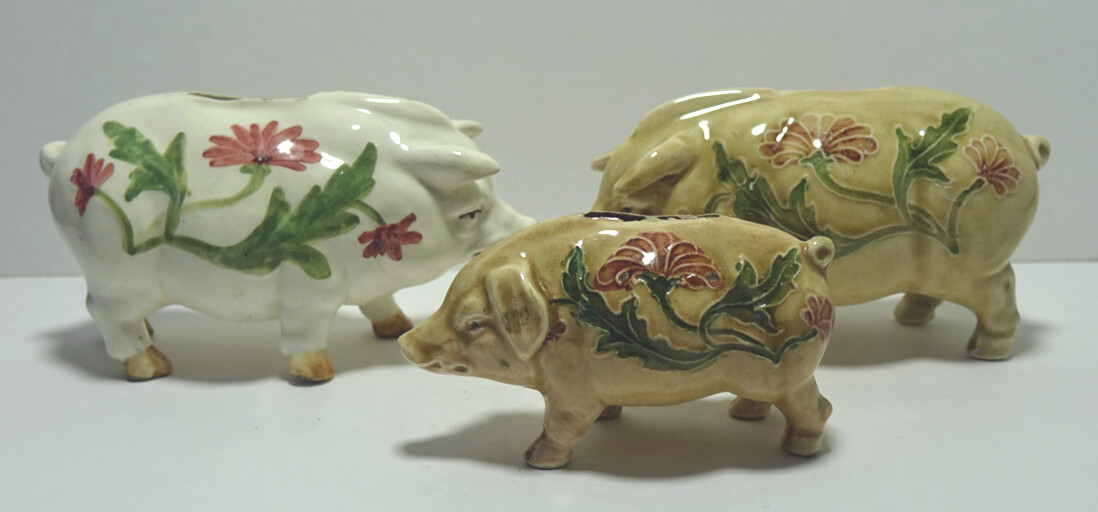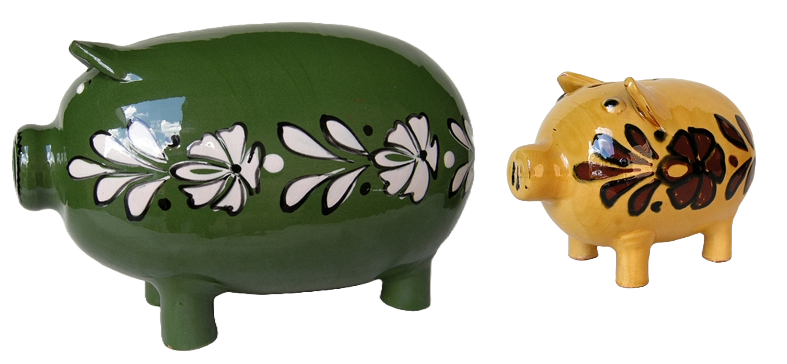CZ/ RO/ HU/ BG
Collection 2

Czechoslovakia/ Czech Republic (CZ)/ Floral decor/ Bulgaria (BG)/ Hungary (HU)
Czechoslovakia (1918 -1993): A piece of history
Czechoslovakia or Czechoslovakia was a republic in Central Europe, created with the collapse of the Danube Monarchy (1867-1918: Austria-Hungary) after the Great War, when the Austrian parts of Bohemia and Moravia were merged with the Hungarian parts of Slovakia. On January 1, 1993, a (peaceful) partition followed in the Czech Republic and Slovakia.
About 25% of all piggy banks produced in Europe before the Great War (1914-1918) came from the former Austro-Hungarian Empire. Also the HEPP piggy banks that can also be seen at “Special Antiques”. The seat of the pottery industry at that time was often Vienna and the factories were located in what after 1918 was called Czechoslovakia or Austria. It may happen that some experts attribute an antique HEPP piggy bank from before 1918 to Austria, while I identify it as Czech (see also blog "History" of 6-7-2019) or vice versa.

These are so-called HEPP piggy banks (Hole Eyed Pottery Pig). These were created in the Austro-Hungarian Monarchy from 1870 to 1918. The Monarchy (1867-1918) consisted of present-day Austria, Hungary, Bosnia and Herzegovina, Croatia, Czech Republic, Slovakia, Slovenia and parts of neighbouring countries. That explains why Austria is one of these pigs and sometimes Chechoslovakia or variants of both. Or no stamp at all, which does not matter for this type because they are recognizable anyway. They are now antique and come in sizes 16 cm to 9.5 cm.

Left: nr. 517 in Stoddard's "Ceramic Coin Banks" mould number 6507-8; right mould 6507-94. Length 14 cm. And up front mould 6457-36. Length 10,5 cm. Antique, 1900-1925;
Czech Republic
On January 1, 1993, Czechoslovakia peacefully split into the Czech Republic and Slovakia. The piggy banks shown are from the Czech Republic, all from the period 1980-2001. In those days one could still buy authentic piggy banks almost everywhere. Nowadays all piggy banks have those awful plastic stoppers. Well known are the piggy banks with hats, which I found nowhere else.

Flower décor pig piggy banks (RO/HU)
These piggy banks with flowers are from Eastern Europe. Romania and Hungary (and occasionally Bulgaria) were the suppliers of former department store V&D that sold them early 1970's in large quantities, along with flower pots and dishes. The flower decorations are hand painted. To create some system in the amount of flower decorated piggy banks I made two categories: 'small and medium' up to 16 cm and 'big' from 16 cm. The smallest is 9.5 cm and the largest in my collection is 29 cm. There are some misunderstandings about these kind of piggy banks: They are not antiques (there are possibly exceptions!) , since they are dated ± 1960-70. Not special pottery, but 'ordinary' farmers pottery, folk art. And that's OK!


Bulgaria and Hungary
- Troyan pottery is considered the true Bulgarian pottery. Traditionally the pottery was painted by the village women. They applied yellow, brown and green paint with a bull’s horn and feathers to achieve a peacock or butterfly like design or smeared paint with their fingertips to achieve a raindrop like effect. Today craftsmen combine traditional designs with modern techniques.
- In this section examples of exchange between former communist "utopia's": In the communist countries the marginal production capacity was a big problem. In a way entrepreneurs were creative to buy the missing products or parts from college communist “utopias”. Not aware of this I always thought that some of the here shown piggy banks that were bought in the GDR were also produced there. Until I decided to ask a native speaker in my home town to translate the label on two of these piggy banks. And found out they were originated in Troyan, Bulgaria.
- Hungarian pottery is still more traditional, modest almost. And to my surprise few Hungarian flower décors in my collection.

"Városlödi Majolika 1830 Hungary". White with flower decor. Length 23,5 cm.













































































































